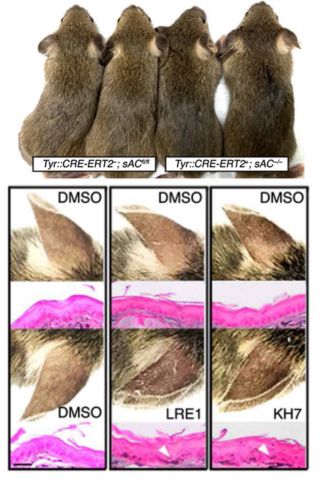Principal Investigator:
Jonathan Zippin, Associate Professor of Dermatology
Background & Unmet Need
- Melanin is a natural pigment responsible for giving color and protecting the skin and eyes from excess ultraviolet (UV) radiation
- Oculocutaneous albinism (OCA) is a group of pigment diseases defined by a loss of pigment in the eyes, skin, and hair
- Loss of pigment has significant psychosocial effects and can lead to vision defects and skin cancer
- Melanin is also implicated in the brain, where neuromelanin is produced using similar mechanisms as the skin
- Patients with Parkinson's only have about 50% of the normal amount of neuromelanin in the substantia nigra, and increased levels of neuromelanin could potentially be used to treat these patients
- Unmet Need: Methods of modulating melanin production and pigmentation for treatment of melanin-related diseases
Technology Overview
- The Technology: Methods to modulate melanin production via soluble Adenylyl Cyclase (sAC) by altering melanosome pH
- The Discovery: The inventor has discovered that sAC, a non-canonical source of cAMP, acts as a pH sensor in a second cAMP-signaling pathway which regulates pigmentation
- Through this pathway, the loss or inhibition of sAC-specific cAMP increases melanin production
- As the most common forms of OCA are due to improper melanosome pH levels, treatment with sAC inhibitors can rescue abnormal pH and pigmentation
- PoC Data: Topical treatment of mice with sAC inhibitors has been shown to increase pigmentation in the skin, eyes and hair
- Intraperitoneal injection of sAC inhibitors restored melanosomal pH to normal levels and increased pigmentation of eyes in a mouse model of OCA type 2
Technology Applications
- Treatment of patients with albinism including oculocutaneous albinism, a group of rare diseases
- Reduction of risk for skin cancer by increasing pigmentation
- Treatment of Parkinson’s Disease via increasing levels of neuromelanin
- Cosmetic applications for the darkening of skin or hair, such as self-tanning lotions or hair coloring
Technology Advantages
- sAC-specific cAMP acts in a distinct cAMP signaling cascade to induce melanin induction, so sAc inhibitors represent a new class of pigment regulators
- sAC inhibitors can be applied topically for area-specific modulation

Figure 1: Top: Loss of sAc via genetic knockout in mice increases pigmentation in the hair Bottom: Topical application of sAC inhibitors LRE1 or KH7 increased melanin and pigmentation in the epidermis.
Publications
Resources
Intellectual Property
Patents
- US Application Filed US20190256856: "Methods of modulating melanosome ph and melanin level in cells"
Cornell Reference
- 7464
Contact Information

For additional information please contact
Brian Kelly
Director, Business Development and Licensing
Phone: (646) 825-2766
Email: bjk44@cornell.edu

